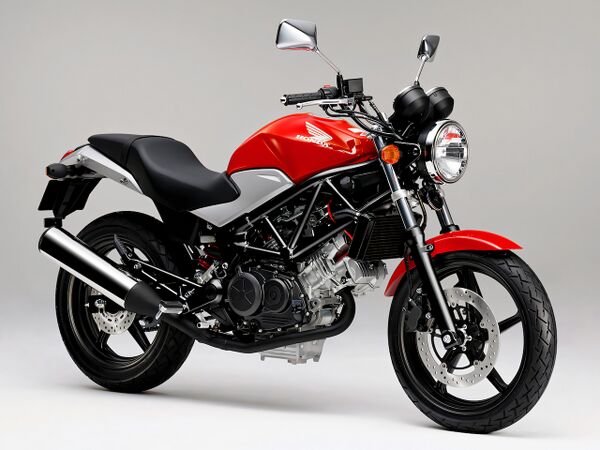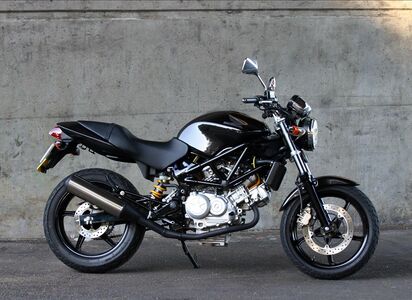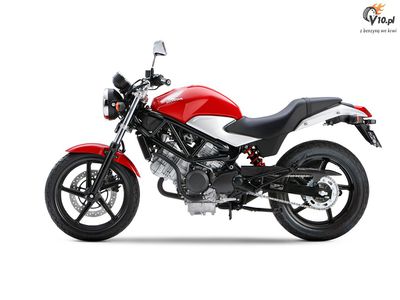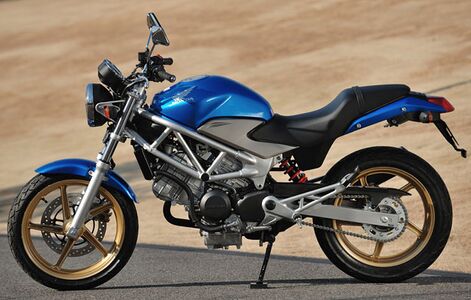Honda VTR250
The Honda VTR 250 road bike was introduced in November 1997 as a budget motorcycle for novice riders. The model became a successor of Honda VT250 Spada, inheriting from it the engine (which was derated, and the 6-speed gearbox was replaced by a 5-speed one). The main sales markets are Japan, Australia, Europe (since 2009).
Main competitors:
The basis of the Honda VTR250 was a 2-cylinder V-shaped (52 °) liquid-cooled engine with a volume of 249 cm³, producing up to 32 hp. power and up to 23 Nm of torque. The maximum performance is at 8500-10500 rpm.
The frame of the motorcycle is a steel diagonal birdcage structure, much like the frame of Ducati road bikes.
For 2009, the Honda VTR 250 undergoes a facelift, with an updated look and injector instead of carburetors. This modification was also supplied to European countries.
In 2013, a new modification appears on the Japanese market - the Honda VTR250F. It is distinguished by the presence of a front half fairing and a headlight of a different shape.
Since 2015, the line has been supplemented by the LD modification - Honda VTR250LD . This version has a lower configuration (reduced overall height, seat height and ground clearance).
2017 was the last year of production of the Honda VTR250, after which it finally left the assembly line. In the same year, Honda releases a limited edition Special Edition in exclusive colors.
Despite the interesting concept, the model is practically not found in Russia and is rarely brought by importers. Low demand is due to a rather high price (in comparison with more cubature models of the same years) and a peculiarity of the mentality of Russian consumers who prefer older, but more powerful models for the same price.
Photos
Specifications
Specifications Honda VTR 250:
| Model | Honda VTR250 |
|---|---|
| Motorcycle type | naked |
| Release year | 1998-2017 |
| Frame | steel diagonal |
| Engine type | 2-cylinder, V-shaped (52 °), 4-stroke |
| Working volume | 249 cm³ |
| Bore / stroke | 60.0 x 44.1 mm |
| Compression ratio | 11.0: 1 |
| Cooling | liquid |
| Number of valves per cylinder | DOHC chain drive, 4 valves per cylinder |
| Fuel supply system | Carburetor, 2x Keihin 32mm - VTR250 (1998-2008)
Injector (PGM-FI), 2x - VTR250 (2009-2017) |
| Ignition type | transistor |
| Maximum power | 32.0 h.p. (23.5 kW) @ 10,500 rpm - VTR250 (carbureted versions)
30.0 h.p. (22.0 kW) @ 10,500 rpm - VTR250 (injection versions) |
| Maximum torque | 23.0 Nm (2.4 kg * m) @ 8500 rpm - VTR250 (carburetor versions)
21.0 Nm (2.2 kg * m) @ 8500 rpm - VTR250 (injection versions) |
| Gearbox | 5-speed |
| Drive type | chain |
| Front tire size | 110 / 70-17 54H - VTR250 (1998-2013)
110/70 R17 M / C 54H - VTR250 (2014-2017) |
| Rear tire size | 140 / 70-17 66H - VTR250 (1998-2013)
140/60 R17 M / C 63H - VTR250 (2014-2017) |
| Front brakes | 1 disc, 296 mm, 2-piston caliper |
| Rear brakes | 1 disc, 220 mm, 1-piston caliper |
| Front suspension | Telescopic fork 41 mm |
| Rear suspension | linkage with monoshock (adjustable preload) |
| Motorcycle length | 2040mm - VTR250 (1998-2002)
2035 mm - VTR250 (2003-2008) 2080 mm - VTR250 (2009-2017) |
| Motorcycle width | 720mm - VTR250 (1998-2002)
725 mm - VTR250 (2003-2017) |
| Motorcycle height | 1050mm - VTR250 (1998-2002)
1055 mm - VTR250 (2003-2017) 1115 mm - VTR250F 1045 mm - VTR250LD |
| Wheelbase | 1410 mm - VTR250 (1998-2002)
1405 mm - VTR250 (2003-2017) |
| Saddle height | 780mm - VTR250 (1998-2002)
760 mm - VTR250 (2003-2013) 755 mm - VTR250 (2014-2017) 740 mm - VTR250LD |
| Minimum ground clearance | 170mm - VTR250 (1998-2002)
155 mm - VTR250 (2003-2017) 145 mm - VTR250LD |
| Acceleration to 100 km / h | 8.0 sec. |
| Maximum speed | 150 km / h |
| Fuel tank capacity | 13.0 L - VTR250 (1998-2008)
12.0 L - VTR250 (2009-2017) |
| Motorcycle weight (curb) | 153 kg - VTR250 (1998-1999)
154 kg - VTR250 (2000-2002) 155 kg - VTR250 (2003-2008) 161 kg - VTR250 (2009-2013) 164 kg - VTR250F (2013) 160 kg - VTR250 (2014-2017) 163 kg - VTR250F (2014-2017) |
Fuel consumption
The officially declared fuel consumption for the Honda VTR 250 is 2.5 liters per 100 kilometers (Japanese calculation method: constant speed 60 km / h, driver + passenger). The real value of the consumption, according to the owners, is 3-3.5 liters per 100 km of track.
Documentation



